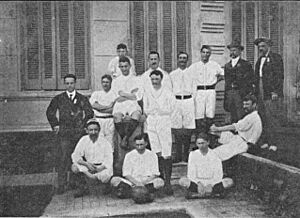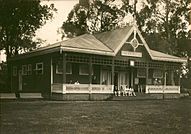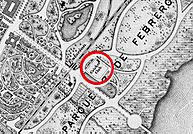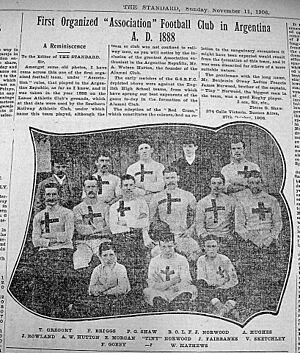Football in Argentina facts for kids
Association football is the most popular sport in Argentina and a huge part of the country's culture. It has the most players, with over 2.6 million people playing, including both registered and unregistered players. There are 3,377 clubs and many officials. Football is a favorite activity for people of all ages, from kids to older adults. About 90% of Argentines support an Argentine football club!
Football came to Argentina in the late 1800s, brought by British immigrants in Buenos Aires. The first Argentine league started in 1891. This makes it one of the oldest football leagues in the world, after England, Scotland, Northern Ireland, and the Netherlands. The Argentine Football Association (AFA) was created in 1893, making it the eighth oldest football association globally.
The Argentina national team is one of only eight teams to have won the FIFA World Cup. They lifted the trophy in 1978, 1986, and 2022. They were also runners-up in 1930, 1990, and 2014. Argentina has won the top South American tournament, the Copa América, a record 15 times. They also won the FIFA Confederations Cup in 1992. Overall, Argentina holds the record for the most official titles won by any nation, with 22.
Argentina's Olympic team has won two Gold Medals in football, in 2004 and 2008. The under-20 team has won a record six U-20 World Cups. At the club level, Argentine teams have won the most Intercontinental Cups (9) and the most Copa Libertadores (25).
Women's football in Argentina has had a national league, the Campeonato de Fútbol Femenino, since 1991. The women's national team first qualified for the World Cup in 2007. They won their first top continental competition, the Campeonato Sudamericano Femenino, in 2006.
In futsal (a type of indoor football), Argentina won the FIFUSA/AMF Futsal World Cup in 1994 and 2019. In FIFA futsal, they were champions in 2016, runners-up in 2021, and fourth in 2004. The team also won the FIFA Futsal Copa América in 2003, 2015, and 2022. Argentina has also been world champion in futsal for visually impaired players in 2002 and 2006. They won a Gold Medal at the IBSA World Blind Games in 2015, and several other medals in Paralympic Games and Copa América tournaments.
Argentina also competes in beach football. Their best result in the World Cup was third place in 2001.
Contents
How Football Started in Argentina
After a difficult time in Argentina's history from 1829 to 1852, leaders wanted to rebuild the country's image. They looked to countries like Western Europe and the United States for ideas. By 1867, many British people lived in Buenos Aires. Most of them worked for British-owned railway companies. These British citizens created social and sports clubs where they could play their favorite sports, including football.
Two English immigrants, Thomas and James Hogg, started the Buenos Aires Football Club on May 9, 1867. The club was allowed to use the cricket field at Parque Tres de Febrero in Palermo, Buenos Aires. The first recorded football match in Argentina happened here on June 20, 1867. The English newspaper The Standard, published in Argentina, covered this match. It was the first newspaper to report on football in the country.
The match was played between two teams of British merchants, called the White Caps and the Red Caps. Teams used caps instead of shirts back then. Each team had eight players because they couldn't find more. The team led by Thomas Hogg won 4–0. This early game was a mix of both association football (soccer) and rugby, and players were allowed to use their hands.
The first report of a football match written in Spanish appeared in the newspaper El Nacional on September 11, 1880. It described a "foot-ball" match in Montevideo between a combined Uruguayan-Argentine team and a British team. About 1,000 people watched.
The "Southern Railway Athletic Club" might have been the first organized team to play by "Association" rules (soccer rules). The Standard newspaper mentioned this team and a match they played in 1888. Alexander Watson Hutton was one of their players.
Growing Popularity and First Leagues
The person often called the "father of Argentine football" was Alexander Watson Hutton. He was a schoolteacher from Glasgow, Scotland. He first taught football at St Andrew's School in Buenos Aires in the early 1880s. In 1884, he founded the Buenos Aires English High School, where he continued to teach the game. In 1891, the "Association Argentine Football League" was created. This was the first football league outside of the British Isles. Five clubs played in it, but only one season was completed.
Many early football clubs were started by employees of British-owned railway companies in Argentina. Some of these teams still exist today, like Ferro Carril Oeste and Rosario Central.
A new league with the same name was formed on February 21, 1893. This league eventually became the Argentine Football Association (AFA) we know today. In these early days, most players and officials were British immigrants. The oldest clubs in Argentina, such as Rosario Central, Newell's Old Boys, and Quilmes, were all founded by British people.

The most successful team from this early period was Alumni. It was founded by students and graduates of Watson Hutton's English High School. Like other early clubs, it was mostly made up of British players.
By the late 1800s, football became very popular among other European immigrants, especially Italians. Many early clubs did not allow local Argentine players. Because of this, Argentino de Quilmes was formed in 1899. It was the first club specifically for Argentine players. The name "Argentino" or "Argentinos" remained popular. A famous team with this name is Argentinos Juniors, who won the Copa Libertadores in 1985.
British football clubs touring South America helped spread football in Argentina in the early 1900s. Southampton F.C. was the first club to tour in 1904. They beat the Buenos Aires High School Alumni team 3-0. Many other British teams visited until 1929.
The early 1900s saw many new clubs being formed. By 1907, there were over 300 teams in Argentina. Most major clubs today were created around this time. As football grew more popular, the British influence slowly decreased. In 1911, Alumni club stopped playing. By 1912, the Association changed its name to the Asociación Argentina de Football in Spanish.
New football leagues started in cities across Argentina as the game spread beyond Buenos Aires. These included leagues in Rosario (1905), Córdoba (1912), and Santa Fe (1913).
Even before an organized league in Rosario, teams like Rosario A.C. and Rosario Central played in the first international tournament in South America, the Tie Cup, starting in 1900. Rosario A.C. was the first team from Rosario to win an international competition in 1902.
The first official match for the Argentina national team was on May 16, 1901, against Uruguay. Argentina won 3–2. This game started the famous football rivalry between Argentina and Uruguay.
Argentina won its first trophy, the Copa Lipton, in 1905. They won their first tournament, the Copa Centenario de la Revolución de Mayo, in 1910. This tournament included Argentina, Uruguay, Brazil, and Chile.
In 1916, Argentina played in the first Copa América. Uruguay won that one. Argentina won the tournament for the first time in 1921 and has now won it a total of 15 times.
In 1928, the Argentina Olympic football team finished second to Uruguay at the Olympics in Amsterdam. Two years later, they played in the first FIFA World Cup, again finishing second to hosts Uruguay.
By 1931, 18 teams decided to form a professional league. The amateur league continued for a few years but eventually closed. This professional league helped keep talented Argentine players from leaving to play for higher-paying European clubs. For example, the 1934 World Cup-winning Italian team had several Argentine-born players.
In 1964, Independiente became the first Argentine club to win the Copa Libertadores. Argentine clubs have won this competition a total of 25 times.
In 1967, Racing was the first Argentine team to win the Intercontinental Cup. Argentine clubs have won this tournament a record 9 times.
In 1978, Argentina hosted the World Cup. The team beat the Netherlands 3–1 in the final to win their first World Cup. The government at the time used the success of the national team to make the country look good, trying to hide problems at home. The victory was used to show an image of stability and success.
In 1979, a young Diego Maradona was part of the Argentina under-20 team that won the FIFA Under-20 World Cup. Argentina has now won a record six U-20 World Cups.
In the early 1980s, many top players left Argentina for Europe because clubs didn't have enough money. Stars like Diego Maradona and Daniel Passarella moved to Spain, France, Italy, or England.
In 1986, Argentina won their second World Cup, beating Germany 3–2 in the final.
In 1995, Rosario Central became the first club outside Buenos Aires to win an international cup recognized by FIFA, the Conmebol Cup.
In 2004, the Argentina Olympic football team won Gold at the Athens Olympic games. They defended their title in 2008, becoming the first team to do so since 1968.
In 2022, Argentina won the World Cup for the third time. They beat France 4–2 in a penalty shootout after a 3–3 draw.
Football Clubs and Leagues
Around 326 registered football clubs play in the Argentine Football Association (AFA) league system. This system has seven levels. The top two levels are national. Below that, the leagues are regional, split between clubs directly connected to AFA and those indirectly connected. There are also almost 250 other regional leagues that can compete to join the main league system.
The Primera División is the top level of club football in Argentina. It started in 1891 as an amateur competition. In 1931, it became professional. For many years, only the "big five" clubs won championships: Boca Juniors, Independiente, Racing Club, River Plate, and San Lorenzo de Almagro. This changed in 1967 when Estudiantes de La Plata won. Since then, 10 other teams have won the championship, making a total of 28 different champions by 2021. River Plate has won the most championships, with 38 titles. Only a few teams from outside Buenos Aires have won the championship.
How Leagues Work
The Primera División has used different ways to organize its championships over the years. Sometimes it was a "round-robin" where every team played each other twice. Other times, it used "Apertura and Clausura" tournaments, where two shorter championships were played in one season.
As of the 2024 season, the Argentine Primera División has 28 teams. They play a single round-robin schedule, meaning each team plays 27 games. Six Argentine teams can play in the Copa Libertadores, a major South American club competition. Four spots come from the league, and two from domestic cups. The next six teams in the league can play in the Copa Sudamericana.
From 1891 until now, River Plate is the most successful team with 38 national championships. Boca Juniors is second with 35 titles. Racing is third with 18 titles.
Winning Teams and Trophies
Besides the main league, several cups have been played in Argentina since 1891. The first cup was the Copa de Honor Municipalidad de Buenos Aires, played from 1905 to 1936.
Today, there are four main domestic cups:
- The Copa Argentina: This cup includes teams from all levels of Argentine football.
- The Supercopa Argentina: This is played between the champions of the Primera División and the Copa Argentina.
- The Copa de la Liga Profesional.
- The Trofeo de Campeones: This started in 2019 and is played between the champions of the Primera División and the Copa de la Superliga Argentina.
The Copa Campeonato is the oldest trophy in Argentine football. It was first awarded in 1896 to the Primera División champion. All these cups are considered official titles.
Exciting Club Rivalries
There are many local rivalries in Argentine football. The most important is the Superclásico, played between Argentina's two most popular and successful teams: River Plate and Boca Juniors from Buenos Aires. The English newspaper The Observer called the superclásico one of the "50 Sporting Things You Must Do Before You Die."
The second most important rivalry is the Avellaneda derby, between Independiente and Racing. Both teams are from the city of Avellaneda, near Buenos Aires. Other important rivalries include:
- Huracán vs. San Lorenzo de Almagro
- The Rosario derby (between Newell's Old Boys and Rosario Central)
- The La Plata derby (between Estudiantes de La Plata and Gimnasia y Esgrima La Plata)
- The Cordoba derby (between Belgrano and Talleres)
The Argentine Style of Play
Football in Argentina developed a special style called "pasture football." This was often played in large, informal games without coaches or strict rules. It included many types of games, from casual matches to more formal ones. This helped players develop skills based on quick thinking and individual talent, especially dribbling (controlling the ball while running). It also led to a more physical defensive style.
Argentine Clubs on the World Stage
The first international club competition was the Tie Cup, started in 1900 by both Argentine and Uruguayan football associations. Many other competitions between clubs from the two countries followed, like the Copa Aldao.
The most successful Argentine club in international competitions is Boca Juniors. They have won a total of 22 international titles, including three Intercontinental Cup titles in 1977, 2000, and 2003.
Independiente has won the most important continental title, the Copa Libertadores, a record seven times. They also won it four times in a row (1972–75). These achievements earned them the nickname Rey de Copas (King of Cups).
Other Argentine clubs that have won the Copa Libertadores include Estudiantes de La Plata and River Plate (four times each), Racing, Argentinos Juniors, Vélez Sarsfield, and San Lorenzo.
Some Argentine teams have won international titles even before winning a national league title. For example, Talleres de Córdoba won the Copa CONMEBOL in 1999, and Defensa y Justicia won the Copa Sudamericana in 2020.
Major International Club Competitions
Argentine clubs have played in these international club competitions:
| Competition | Years | Organizer/s |
|---|---|---|
| Tie Cup | 1900–1919 | AFA / AUF |
| Copa de Honor Cousenier | 1905–1920 | AFA / AUF |
| Copa Aldao | 1913–1955 | AFA / AUF |
| Copa Libertadores | 1960–present | CONMEBOL |
| Intercontinental Cup | 1960–2004 | CONMEBOL / UEFA / FIFA |
| Copa Interamericana | 1968–1998 | CONMEBOL / CONCACAF |
| Intercontinental Supercup | 1968–1970 | CONMEBOL / UEFA |
| Supercopa Libertadores | 1988–1997 | CONMEBOL |
| Recopa Sudamericana | 1989–present | CONMEBOL |
| Copa Master de Supercopa | 1992–1995 | CONMEBOL |
| Copa Conmebol | 1992–1999 | CONMEBOL |
| Copa de Oro | 1993–1996 | CONMEBOL |
| Copa Mercosur | 1998–2001 | CONMEBOL |
| Copa Sudamericana | 2002–present | CONMEBOL |
| FIFA Club World Cup | 2005–present | FIFA |
| Suruga Bank Championship | 2008–2019 | CONMEBOL / J.League |
Football's Place in Argentine Culture
Football helped bring people from different neighborhoods together in Argentina and build a shared national identity. People from all social classes, including British immigrants and workers, connected through the game. This love for football grew into a strong passion that unites Argentines across different backgrounds.
Football is a huge part of life for many Argentines. Even if they don't go to matches, they watch them on TV and talk about them with friends and co-workers the next day. When the Argentina national football team plays, especially during World Cup matches, streets often become empty because everyone is watching. Football is a way for Argentina to express its culture. The way the game is played, celebrated, and discussed shows the country's character. The chants, traditions, and rituals around football add to Argentina's unique cultural identity. Chants like “Vamos, vamos, Argentina!” show national pride. The song Ole Ole Ola talks about how much Argentines love their country. After World Cup victories in 1978 and 1986, streets were filled with people celebrating.
In the 1920s, with the rise of mass media and the first generation of immigrant children being born, the Argentine government used the men's national football team to connect with these new citizens. The media wrote about how well the team played and how they created their own national style. This helped people feel proud of their nationality.
In 1986, Diego Maradona became a huge icon not just for Argentine football but for football worldwide. In Argentina, many fans admired him like a god. He represented national pride and was loved by fans of all clubs.
Lionel Messi's success and talent also bring pride and unity to Argentines. His achievements, like leading Argentina to international victories, are celebrated as national triumphs. His global fame has made him a marketable figure, helping to shape Argentina's image around the world.
Fans in Argentine football stadiums follow a principle called Aguante (Endurance). This is a belief system that guides how they behave. Key values of aguante include courage, endurance, and being fearless in physical situations. Fans show these values by always supporting their team with chants and jumping, attending almost every match, and standing strong against insults from opposing fans.
Under aguante, fans are grouped into categories: hinchas (fans), hinchinda militantes (militant fans), and espectadores (spectators). Hinchas show many aguante qualities and go to many matches. Hinchinda militantes are usually behind the goals and strictly follow aguante by attending every match, no matter the weather or team performance. Espectadores go to enjoy the game but don't follow aguante as strictly.
Within hinchinda militantes, there are subgroups like la barra (supporters), la banda (the band), los pibes (the kids), and la pandilla (gang). La Barra groups are very important for creating the stadium atmosphere. They have a leader (capo) who organizes things. These groups, mostly men aged 15–50, show their aguante to gain benefits from club executives, like tickets or permission to bring instruments into the stadium.
The excitement and passion at stadiums often come from the percussion and brass instruments brought by barras groups. These include drums, snare drums, tambourines, and trumpets. While the music creates unity, it can also lead to bad behavior, like derogatory language and violence.
Since 2013, Argentine fans are not allowed to travel to away matches due to violence. This ban has made the atmosphere in many stadiums less exciting, with goals for away teams met by silence and fewer "round trip chants" between home and away fans.
Barra bravas (organized Argentine fan groups) sometimes cause problems, usually with riots after matches.
Famous Football Stadiums
Argentina has many large football stadiums. Here are some of the major ones with over 50,000 seats:
- Mâs Monumental (River Plate – 84,567 spectators)
- La Bombonera (Boca Juniors – 57,200)
- Mario Kempes (owned by Córdoba Province – 57,000)
- Ciudad de La Plata (Buenos Aires Province – 53,000)
Stadiums with over 45,000 seats include:
- José Amalfitani (Vélez Sársfield – 49,540)
- Tomás Adolfo Ducó (Huracán – 48,314)
- Pedro Bidegain (San Lorenzo – 47,964)
- Ciudad de Lanús (C.A. Lanús – 47,090)
Images for kids
See also
 In Spanish: Fútbol en Argentina para niños
In Spanish: Fútbol en Argentina para niños
- Sport in Argentina







